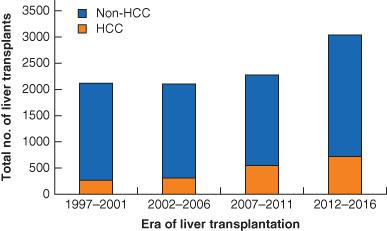当前位置:
X-MOL 学术
›
Br. J. Surg.
›
论文详情
Our official English website, www.x-mol.net, welcomes your
feedback! (Note: you will need to create a separate account there.)
Short- and long-term mortality after liver transplantation in patients with and without hepatocellular carcinoma in the UK.
British Journal of Surgery ( IF 8.6 ) Pub Date : 2020-03-03 , DOI: 10.1002/bjs.11451 D Wallace 1, 2 , T E Cowling 1 , K Walker 1 , A Suddle 2 , I Rowe 3, 4 , C Callaghan 5 , A Gimson 6 , W Bernal 2 , N Heaton 2 , J van der Meulen 1
British Journal of Surgery ( IF 8.6 ) Pub Date : 2020-03-03 , DOI: 10.1002/bjs.11451 D Wallace 1, 2 , T E Cowling 1 , K Walker 1 , A Suddle 2 , I Rowe 3, 4 , C Callaghan 5 , A Gimson 6 , W Bernal 2 , N Heaton 2 , J van der Meulen 1
Affiliation

|
BACKGROUND
The increasing demand for liver transplantation has led to considerable changes in characteristics of donors and recipients. This study evaluated the short- and long-term mortality of recipients with and without hepatocellular carcinoma (HCC) in the UK between 1997 and 2016.
METHODS
First-time elective adult liver transplant recipients in the UK were identified and four successive eras of transplantation were compared. Hazard ratios (HRs) comparing the impact of era on short-term (first 90 days) and longer-term (from 90 days to 5 years) mortality were estimated, with adjustment for recipient and donor characteristics.
RESULTS
Some 1879 recipients with and 7661 without HCC were included. There was an increase in use of organs donated after circulatory death (DCD), from 0 per cent in era 1 to 35·2 per cent in era 4 for recipients with HCC, and from 0·2 to 24·1 per cent for non-HCC recipients. The 3-year mortality rate decreased from 28·3 per cent in era 1 to 16·9 per cent in era 4 (adjusted HR 0·47, 95 per cent c.i. 0·35 to 0·63) for recipients with HCC, and from 20·4 to 9·3 per cent (adjusted HR 0·44, 0·36 to 0·53) for those without HCC. Comparing era 4 with era 1, improvements were more marked in short-term than in long-term mortality, both for recipients with HCC (0-90 days: adjusted HR 0·20, 0·10 to 0·39; 90 days to 5 years: adjusted HR 0·52, 0·35 to 0·75; P = 0·043) and for non-HCC recipients (0-90 days: adjusted HR 0·32, 0·24 to 0·42; 90 days to 5 years: adjusted HR 0·52, 0·40 to 0·67; P = 0·024).
CONCLUSION
In the past 20 years, the mortality rate after liver transplantation has more than halved, despite increasing use of DCD donors. Improvements in overall survival can be explained by decreases in short-term and longer-term mortality.
ANTECEDENTES
La creciente demanda de trasplante hepático ha determinado cambios considerables en las características de los donantes y receptores. En este estudio, se evaluó la mortalidad a corto y a largo plazo de los receptores de trasplante hepático por carcinoma hepatocelular (hepatocelular carcinoma, HCC) y no-HCC en el Reino Unido entre 1997 y 2016. MÉTODOS: Se identificaron los receptores adultos de un primer trasplante hepático electivo en el Reino Unido y se compararon cuatro eras sucesivas de trasplante. Se estimaron los cocientes de riesgos instantáneos ajustados (adjusted hazard ratio, aHR) que comparaban el impacto de la era en la mortalidad a corto plazo (primeros 90 días) y a largo plazo (de 90 días a 5 años) ajustando por las características del receptor y del donante.
RESULTADOS
Se incluyeron 1.879 receptores HCC y 7.661 receptores no-HCC. Hubo un aumento en el uso de donantes después de parada cardíaca (donors following circulatory death, DCD) del 0% en la era 1 al 35,2% en la era 4 para los receptores HCC y del 0,2% al 24,1% para los receptores no-HCC. La mortalidad a los 3 años disminuyó de 28,3% en la era 1 a 16,9% en la era 4 (aHR 0,47, i.c. del 95% 0,35-0,63) para receptores HCC y de 20,4% a 9,3% (aHR 0,44, 0,36-0,53) para receptores no-HCC. Comparando la era 1 y la era 4, las mejoras en la mortalidad a corto plazo fueron más marcadas que en la mortalidad a largo plazo, tanto para receptores HCC (aHR 0-90 días 0,20, 0,10-0,39; 90 días-5 años 0,52, 0,35-0,75; P =舁0,04) como para receptores no-HCC (aHR 0-90 días 0,32, 0,24-0,42; 90 días-5 años 0,52, 0,40-0,67; P =舁0,02). CONCLUSIÓN: En los últimos 20 años, la mortalidad después del trasplante de hígado se ha reducido a más de la mitad, a pesar del uso cada vez mayor de donantes DCD. Las mejoras en la supervivencia global pueden explicarse por la disminución de la mortalidad a corto y largo plazo.
中文翻译:

英国有或没有肝细胞癌患者肝移植后短期和长期死亡率。
背景技术对肝移植的需求的增加已经导致供体和受体特征的相当大的变化。这项研究评估了1997年至2016年英国有或没有肝细胞癌(HCC)的接受者的短期和长期死亡率。方法确定了英国的首次选择性成人肝移植接受者,并确定了四个连续的移植时代比较。估算了危险程度,比较了时代对短期(头90天)和长期(从90天到5年)死亡率的影响,并根据接受者和捐赠者的特征进行了调整。结果纳入了约1879名有HCC的接受者和7661名无HCC的接受者。循环死亡(DCD)后捐赠的器官的使用有所增加,对于HCC接收者,从1年代的0%到4时代的35·2%,对于非HCC接收者,从0·2到24·1%。对于HCC接受者,三年死亡率从1时代的28 3%降低到4时代的16 9%(HR 0 47,95%ci 0 35至0 63);以及对于没有HCC的患者,比例从20·4到9·3%(将HR 0·44、0·36调整为0·53)。将HCC的接受者(第0-90天:调整后的HR 0·20、0·10到0·39;将90天改为HR),将第4代与第1代相比,短期死亡率的改善要远高于长期死亡率。 5年:调整后的HR 0·52,0·35至0·75; P = 0·043)和非HCC接受者(0-90天:调整后的HR 0·32,0·24至0·42; 90天至5年:调整后的HR为0·52,0·40为0·67; P = 0·024)。结论在过去的20年中,肝移植后的死亡率降低了一半以上,尽管增加了DCD供体的使用。总体生存率的提高可以通过降低短期和长期死亡率来解释。背景技术对肝移植的需求的增长已经导致供体和受体特征的相当大的变化。在这项研究中,确定了1997年至2016年间在英国接受肝细胞癌(HCC)和非HCC的肝移植受者的短期和长期死亡率。比较了英国的首次选择性肝移植和连续四个移植时代。调整后的危险比(调整后的危险比,aHR)比较了该时代对短期(头90天)和长期(90天至5年)死亡率的影响,并根据接受者和捐赠者的特征进行了调整。结果包括1879名HCC接受者和7661名非HCC接受者。对于HCC接受者,心脏骤停后(循环死亡后的供体,DCD)的供体使用率从第1代的0%增加到第4代的35.2%,从第4代增加非HCC收件人的百分比。对于HCC和20位接受者,3年死亡率从1时代的28.3%降低至4时代的16.9%(aHR 0.47,95%ic 0.35-0.63),非HCC受体为4%至9.3%(aHR 0.44,0.36-0.53)。比较1期和4期,对于HCC接受者(aHR 0-90天为0.20,0.10-0.39;90天5年0.52,0.35-0.75; P =舁0.04)(非HCC接受者)(aHR 0-90天0.32,0.24-0.42; 90天-5年0.52,0.40-0.67; P =舁0.02)。结论:在过去的20年中,尽管增加了DCD供体的使用,但肝移植后的死亡率却降低了一半以上。总体生存率的提高可以通过短期和长期内死亡率的降低来解释。
更新日期:2020-03-03
中文翻译:

英国有或没有肝细胞癌患者肝移植后短期和长期死亡率。
背景技术对肝移植的需求的增加已经导致供体和受体特征的相当大的变化。这项研究评估了1997年至2016年英国有或没有肝细胞癌(HCC)的接受者的短期和长期死亡率。方法确定了英国的首次选择性成人肝移植接受者,并确定了四个连续的移植时代比较。估算了危险程度,比较了时代对短期(头90天)和长期(从90天到5年)死亡率的影响,并根据接受者和捐赠者的特征进行了调整。结果纳入了约1879名有HCC的接受者和7661名无HCC的接受者。循环死亡(DCD)后捐赠的器官的使用有所增加,对于HCC接收者,从1年代的0%到4时代的35·2%,对于非HCC接收者,从0·2到24·1%。对于HCC接受者,三年死亡率从1时代的28 3%降低到4时代的16 9%(HR 0 47,95%ci 0 35至0 63);以及对于没有HCC的患者,比例从20·4到9·3%(将HR 0·44、0·36调整为0·53)。将HCC的接受者(第0-90天:调整后的HR 0·20、0·10到0·39;将90天改为HR),将第4代与第1代相比,短期死亡率的改善要远高于长期死亡率。 5年:调整后的HR 0·52,0·35至0·75; P = 0·043)和非HCC接受者(0-90天:调整后的HR 0·32,0·24至0·42; 90天至5年:调整后的HR为0·52,0·40为0·67; P = 0·024)。结论在过去的20年中,肝移植后的死亡率降低了一半以上,尽管增加了DCD供体的使用。总体生存率的提高可以通过降低短期和长期死亡率来解释。背景技术对肝移植的需求的增长已经导致供体和受体特征的相当大的变化。在这项研究中,确定了1997年至2016年间在英国接受肝细胞癌(HCC)和非HCC的肝移植受者的短期和长期死亡率。比较了英国的首次选择性肝移植和连续四个移植时代。调整后的危险比(调整后的危险比,aHR)比较了该时代对短期(头90天)和长期(90天至5年)死亡率的影响,并根据接受者和捐赠者的特征进行了调整。结果包括1879名HCC接受者和7661名非HCC接受者。对于HCC接受者,心脏骤停后(循环死亡后的供体,DCD)的供体使用率从第1代的0%增加到第4代的35.2%,从第4代增加非HCC收件人的百分比。对于HCC和20位接受者,3年死亡率从1时代的28.3%降低至4时代的16.9%(aHR 0.47,95%ic 0.35-0.63),非HCC受体为4%至9.3%(aHR 0.44,0.36-0.53)。比较1期和4期,对于HCC接受者(aHR 0-90天为0.20,0.10-0.39;90天5年0.52,0.35-0.75; P =舁0.04)(非HCC接受者)(aHR 0-90天0.32,0.24-0.42; 90天-5年0.52,0.40-0.67; P =舁0.02)。结论:在过去的20年中,尽管增加了DCD供体的使用,但肝移植后的死亡率却降低了一半以上。总体生存率的提高可以通过短期和长期内死亡率的降低来解释。











































 京公网安备 11010802027423号
京公网安备 11010802027423号